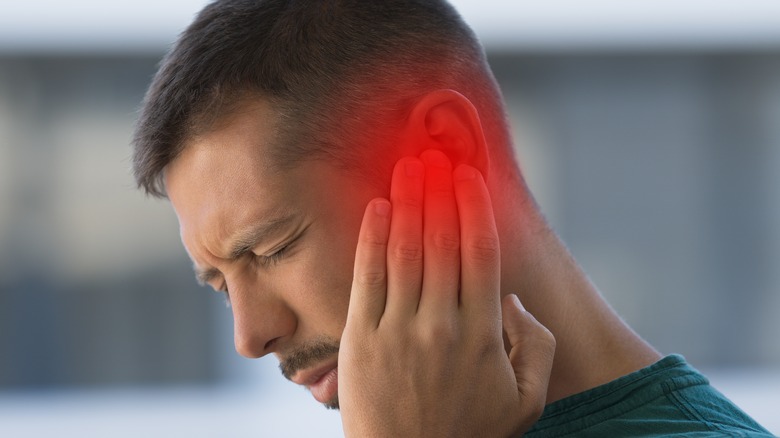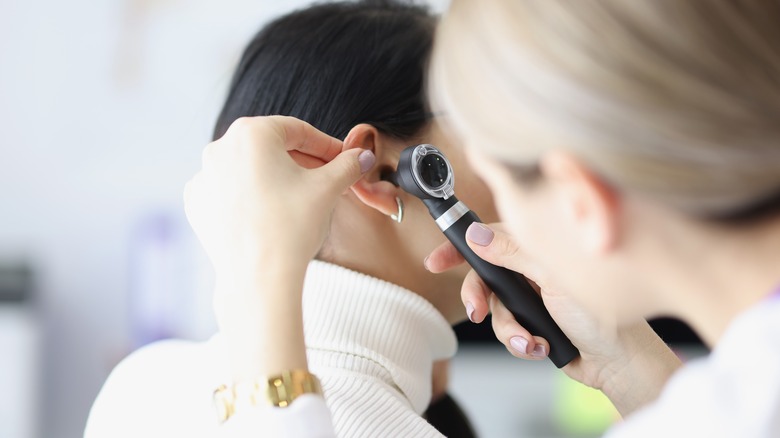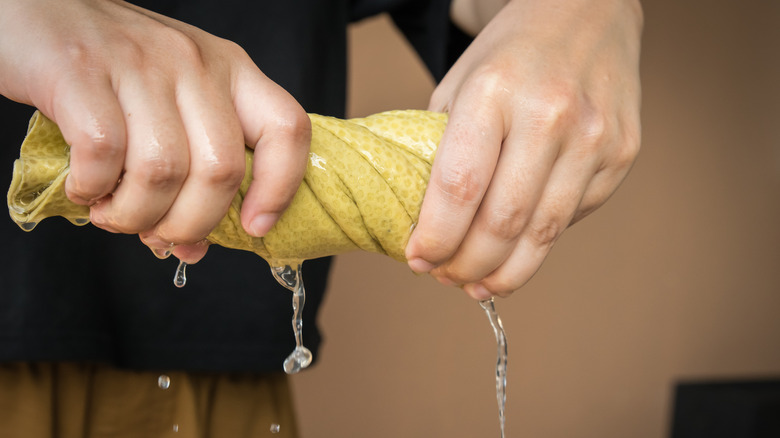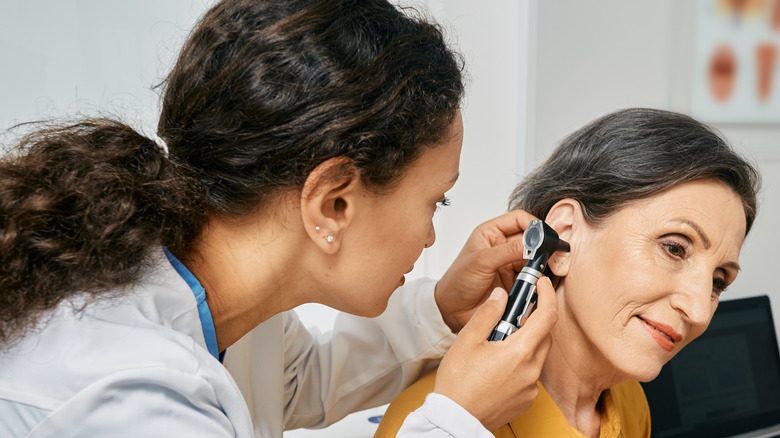Simple Tips For Treating An Ear Infection At Home
According to the Ear, Nose, and Throat Institute, ear infections account for around 30 million doctor visits yearly. There are many different types of ear infections — each type can be caused by a variety of factors, including viral or bacterial infections, allergies, and structural abnormalities in the Eustachian tubes, per MedicalNewsToday. According to the source, ear pain and pressure are the most common symptoms of adult ear infections. An ear infection can also cause difficulty hearing or sleeping, loss of balance, and loss of appetite in children. Some children may also develop a fever, and in some cases, fluid can build up in the middle ear.
There are a few things you can do to help alleviate symptoms and treat ear infections at home. In some cases, an ear infection may resolve itself with time. However, it's still important to seek medical attention as soon as possible, as serious complications can arise if an ear infection is left untreated.
Types of ear infections
The effectiveness of home remedies may depend on the type of ear infection you have. There are several types, which can be broadly categorized into two: outer and middle ear infections.
Middle ear infections are typically caused by a buildup of fluid in the middle ear, which can be the result of a cold, allergies, or a blocked Eustachian tube, says the Mayo Clinic. The fluid can become infected with bacteria or viruses, leading to inflammation and pain. Symptoms of a middle ear infection can include ear pain, difficulty hearing, fever, and a loss of balance.
Outer ear infections — also known as otitis externa or swimmer's ear — are typically caused by bacteria or fungus and can occur in the ear canal, according to Healthline. Symptoms include itching, pain, and drainage from the ear.
Inner ear infections (otitis interna) are usually caused by a viral or bacterial infection that spreads from the middle ear to the inner ear, per the Cleveland Clinic. Common symptoms include vertigo, nausea, ringing in the ear, and a feeling of fullness in the ears.
Using a warm or cold compress
According to the Cleveland Clinic, a warm or cold compress are helpful remedies for ear infections. The heat from a warm compress or heating pad can help reduce pain by increasing blood flow and speeding up the healing process (via Healthline). To make a warm compress, fill a small bowl with hot water and soak a towel. Squeeze out any excess water from the towel and place the warm compress against the affected ear for 20 minutes at a time, per Healthline.
A cold compress, on the other hand, can help to numb the area and reduce pain and swelling, per Healthline. To use a cold compress, fill a small bag with ice and wrap it in a towel. Place the cold compress against the affected ear for 20 minutes. It's crucial to note that a warm or cold compress should not be applied directly to the skin, as it could cause a burn or frostbite. Always wrap the compress in a towel or cloth before applying it to the ear.
It's also vital to note that a warm or cold compress should not be used as the sole treatment for an ear infection. You should use it in conjunction with medications prescribed by a doctor. Also, be mindful of the temperature of the compress; it should not be too hot or too cold, as this might cause discomfort.
Taking over-the-counter pain medications
Over-the-counter (OTC) pain relievers are another common treatment option for ear infections. These medications can help to reduce pain and inflammation associated with ear infections. The most common OTC pain relievers used for ear infections are acetaminophen and ibuprofen, per the Mayo Clinic. Acetaminophen, also branded as Tylenol, is a pain reliever that works by numbing nerve signals that cause pain and fever (via MedicalNewsToday). Ibuprofen, also branded as Advil and Motrin, is a non-steroidal anti-inflammatory drug (NSAID) that reduces hormones that cause inflammation and pain (via Drugs.com). In addition, you can use OTC ear drops to alleviate pain and inflammation associated with ear infections. These ear drops contain the active ingredient benzocaine, a local anesthetic that numbs the area around the ear, per MedlinePlus.
When taking any pain medication, always follow the dosing instructions on the packaging for these medications and do not exceed the recommended dosage. Also, check with a doctor before administering medication to children and pay attention to any warnings or precautions on the package.
The benefits of sleeping upright
When recovering from an ear infection, it's important to get plenty of sleep since rest is an important aspect of recovery. The body needs time and energy to fight off the infection and heal itself. Getting enough rest can help to reduce pain and inflammation, and it can also help speed up the healing process, says the Sleep Foundation. The foundation advises getting sufficient hours of sleep each night. It's also a good idea to take short naps during the day if you feel tired or if your symptoms are making it difficult to sleep at night.
Sleeping upright can be an effective way to alleviate discomfort and pain associated with ear infections. When lying down, fluid can build up in the middle ear, which can increase pressure and cause pain, says WebMD. By sleeping upright, the fluid can drain out of the ear more easily, reducing pressure and pain, per WebMD. There are several ways to sleep upright when you have an ear infection. The source advises propping yourself up with an extra pillow while sleeping. This will help to keep your head elevated and allow fluid to drain out of the ear more easily. Also, a recliner chair can be a great option for sleeping upright, as it allows you to adjust the angle of the backrest to a comfortable position.
When to see a doctor for an ear infection
Some ear infections can lead to serious complications if left untreated, so it's important to get a proper diagnosis and treatment. If you're experiencing severe or persistent symptoms, or if your symptoms aren't improving with home remedies, medical attention is needed to rule out anything serious. It's also important to see a doctor if you have a fever, you're experiencing difficulty hearing, or experiencing hearing loss. If an infant or young child is physically very weak, very sick, in severe pain, or has a fever over 104 degrees Fahrenheit, immediate medical attention is also needed, per the Cleveland Clinic.
An ear infection is typically diagnosed by a doctor through a physical examination of the ear, as well as a review of the patient's symptoms. Your doctor may use an otoscope — a tool with a light and magnification feature — to look inside the ear canal and check for redness, swelling, and other signs of infection. They may also perform a test called tympanometry to assess the mobility and performance of the eardrum. In some cases, your doctor may also take a sample of fluid from the ear to check for bacteria or viruses, per the Mayo Clinic.






